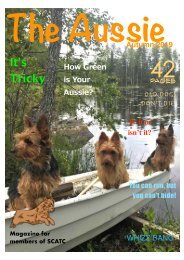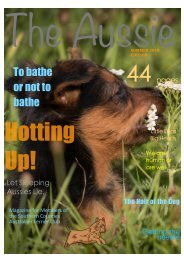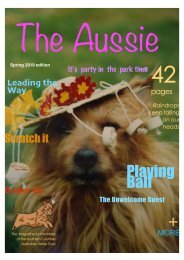The Aussie - Summer 2020 final
Magazine for members of the Southern Counties Australian Terrier Club
Magazine for members of the Southern Counties Australian Terrier Club
You also want an ePaper? Increase the reach of your titles
YUMPU automatically turns print PDFs into web optimized ePapers that Google loves.
When I started to exhibit in 1927 I was given a copy of a
standard taken from the dog column of a weekly publica<on
The Leader. This allowed the two types of ears, but preferred
pricked ears, while black and tan was introduced as an
allowed colour but no men<on was made of sandy.
In 1928 in the kennel column of The Leader, a standard for
Australian Terriers was published which it was stated was the
result of consulta<on and agreement between breeders and
clubs in Victoria, South Australia and Tasmania. In this, the
only changes were the disallowance of ears dropped forward,
the dele<on of black and tan, and inclusion of sandy. This
standard has remained unchanged and was apparently
adopted by the controlling bodies some <me aber 1928.
Although the origin of the Australian Terrier is not actually
known, we do know that a terrier-type dog known as the
Tasmanian Rough Coat-ed Terrier was developed in Tasmanian
the early days of the colony.
Some <me ago I discovered in an early book of the Cairn
Terrier that an Ensign MacDonald was posted to 99th
Regiment of Foot in Hobart Town. He was the son of
MacDonald of Neish, one of the very early pioneers of the
dogs we now know as the Cairn Terrier.
These Cairn Terriers were the forebears of the ScoMsh Terrier
and West Highland White, while the Skye Terrier is believed to
be the result of out-crossing the original Cairn in the Hebrides.
Ensign MacDonald brought to Hobart six terriers from his
father’s kennel. When the regiment was transferred to Cork
only two of the terriers returned with him. These dogs could
probably have been used to produce the Tasmanian Rough
Coated Terrier by crossing with Yorkshire Terriers which would
almost certainly have been brought out in the early fleets.
There are certainly marked similari<es between Cairns and
Australian Terriers.
There is no doubt that the Tasmanian Rough Coated Terrier
was, by selec<ve breeding, developed into the Australian
Terrier.
In the late 1920’s Australian Terriers in some of the Tasmanian
kennels were becoming a liUle light in bone structure due to
in-breeding and at least two breeders in Hobart, who had
heard that a ScoMsh breed of terrier had been used early in
the development, assumed that the ScoMsh terriers, as we
know them now, was used and crossed a ScoMsh Terrier into
their kennel with disastrous results. As a result, both these
breeders - Mr. D Saunders and Mr C Hosper - ceased breeding
Australian Terriers and concentrated on ScoMsh Terriers.
This kennel disappeared from the show ring in the early
1930’s, although judicious use of stock from this kennel may
have helped improve the tan colouring in stock from other
kennels.
In 1928 I purchased my first Australian Terrier bitch from Mr F.
Richardson. She was Medorah Julie, by Northumberland
Punch from Northumberland Trixie.
Prior to my purchasing Medorah Julie, she had produced a
dog Medorah Pat, who won best of breed at six months of
age and, up <ll the <me of Mr. Richardson’s death in 1932,
was never beaten by any other Australian Terrier. In my
opinion this dog was the best Australian Terrier I have seen,
even up to the present <me.
lIn Mr. Gil. Brown’s book in the Australian breeds, he states
that Mr. A.A. Laidlaw of Ararat purchased the Parkville
kennels from Mr. McGowan in Launceston which then ceased
to exist and the Ripon kennel came into being. This cannot be
correct for the following reasons: Aber the death of Mr. Fred
Richardson I acquired an outstanding bitch - Medorah Trixie.
This bitch was bred from a bitch Royston Trixie, purchased by
Mr. E. McCracken from Victoria (for the then large sum of
sixteen guineas), and sired by Northumberland Punch.
At this <me I was living at Lilydale just out of Launceston. I
later gave this bitch and a dog Durnsford Bill (out of Medorah
Julie by Medorah Nip, a liUer brother to Medorah Pat) to a
Mr. A. Brooks. These two terriers were given to Mr. Brooks to
his uncle, Col McGowan, who established the Parkville
kennels using these two terriers as his founda<on stock. This
was in 1933.
In 1929 Mr. Fred Richardson purchased two bitches from
Victoria, one of these was Ripon Rosie, from the Ripon
kennels and another from a kennel in Ballarat with the kennel
name Sturt. So it is clear that Ripon Kennels were in existence
at least four years before Parkville. Further, Parkville kennels
were s<ll opera<ve up un<l the end of World War II A very
nice dog Shwebo Tiger, out of Trixie by Parkville Tiger, bred
and owned by Capt. George Cooper, was being exhibited with
a lot of success, winning Best in Show and many Group
awards.
Newspaper ar<cle
featuring Jim Watson's
views on the Aussie
breeding.
Another breeder and exhibitor, Mr James Hogan of the
Athelmore prefix, imported from the U.K. a Manchester
Terrier, which was bred to Australian Terrier bitches.
Photographs from the Illustrated Tasmanian Mail, dated from
1923 to 1932, indicated the deteriora<on of type
in this kennel in 1932 with the disastrous result of this
Manchester cross.









